
| WWT Shows | CLICK TO: Join and Support Internet Horology Club 185™ | IHC185™ Forums |

|
• Check Out Our... • • TWO Book Offer! • |
Welcome Aboard IHC185™  Internet Horology Club 185
Internet Horology Club 185  IHC185™ Discussion Site Main Page
IHC185™ Discussion Site Main Page  Open to the World RESEARCH FORUMS
Open to the World RESEARCH FORUMS  Ball Watch Company Research Forum
Ball Watch Company Research Forum  Ball - Waltham B of L E Pocket Watch
Ball - Waltham B of L E Pocket Watch
 Internet Horology Club 185
Internet Horology Club 185  IHC185™ Discussion Site Main Page
IHC185™ Discussion Site Main Page  Open to the World RESEARCH FORUMS
Open to the World RESEARCH FORUMS  Ball Watch Company Research Forum
Ball Watch Company Research Forum  Ball - Waltham B of L E Pocket Watch
Ball - Waltham B of L E Pocket WatchGo  | New Topic  | Find-Or-Search  | Notify  | Tools  | Reply to Post  |  |
I have a Ball - Waltham number B0554395 which is a 16 size, 19 jewel B of L E watch. Cheers! Joel | |||
|
| IHC President Life Member |
Nice item Joel, Interestingly yours is B0554395 and I have a nearly identical 19-Jewel BofLE number B0554261 in my collection. Both watches are of course from the same 1901 Ball-Waltham run. Thanks for sharing your information. Lindell | |||
|
As usual I'm confused. I'm not trying to belittle anyone's watch but have a question about the dial vs movement since the dial is Ball & Co and the movement is Ball Watch Co? Is this the way it would have/could have come when new or has the dial been replaced? Thanks for the information. Clayton | ||||
|
Gosh, Clayton, I really don't have a good answer for you! "Could Have?" Maybe. Would have, possibly. I have handled a few 16 size Ball "brotherhood" watches, and all the ones I have seen seem to have this discrepancy. I have not seen a Ball-Waltham 16 size marked, Ball & Company. There MAY be exceptions, however. We must remember that above all, Ball was a merchant. Could the dials have been done before the name change? Who knows? To bring us to the present time, Ball "brotherhood" dials are rare, and as far as I know, and I have had this watch as is for some 25 years, there hasn't been any replacement here. Thank you, Clayton, for the good questions! Lindell, what do you think? Cheers! Joel | ||||
|
I see three Waltham brotherhood dials on Ebay currently and all three are Ball & Co. Two of these dials are on watches that are Ball Watch Co (B0554395 & B213045). I know of two other earlier Waltham movements (B061063--marked ORC and B134768--marked BLE) both being Ball & Co. Neither have brotherhood dials so that is no help in determining what is or should be. I don't recall seeing a Waltham 16s brotherhood dial with Ball Watch Co. but I don't see many and certainly haven't noticed. STILL CONFUSED. Clayton | ||||
|
| IHC President Life Member |
Clayton, PLEASE CONSIDER THIS SUGGESTION: Do not buy a Ball Brotherhood movement without a Brotherhood dial unless you have or know where to find a correct dial. The gold-plated brass "plugs" in the movement are held in with a little set-screw and therefore can be changed. Recently some left-over Brotherhood plugs have surfaced and mark my word we will see newly christened "brotherhood movements" coming out of the woodwork. There have always been far more movements than dials so now that will only get worse! Always remember, every Ball Brotherhood movement originally came with a Brotherhood dial. Now to your earlier question which I too have often contemplated... You can see the evolution of "Ball and Company" to "Ball Watch Company" on Early 18-size Ball-Hamiltons continuing on the Ball-Elgins through the end of 18-size Ball Watches on Later 18-size Ball-Hamiltons at these linked images. This changeover in signature began right after the turn of the Twentieth Century and seems to be completed by the 1904-1905 era. However you will notice the "B of L E" marked dial even on a later Ball-Hamilton example number 644007 from 1910 production and 1914 release still displays a "Ball & Co" signature. I can only think of two answers, perhaps the trade-mark stayed with Ball & Company and was not carried over during the Ball Watch Company reorganization. That sounds unlikely, so we may be left to conclude they had a sufficient number of marked "Ball & Co" dials on-hand and so there was no need to manufacture any with the later signature. Re-focusing on Ball-Waltham dials and responding more precisely, I have a later Ball-Waltham Order of Railway Conductors and a Brotherhood of Locomotive Firemen and Enginemen with "Ball Watch Co" dial signature but I cannot locate nor do I have a recollection of seeing any Brotherhood of Locomotive Engineers black-on-white signature dial with "Ball Watch Co" marking. From that I think Joel's B0554395 and the nearly identical 19-Jewel BofLE number B0554261 in my collection from the same 1901 Ball-Waltham run are most likely correctly configured. "Ball & Co" Brotherhood of Locomotive Engineers dial... 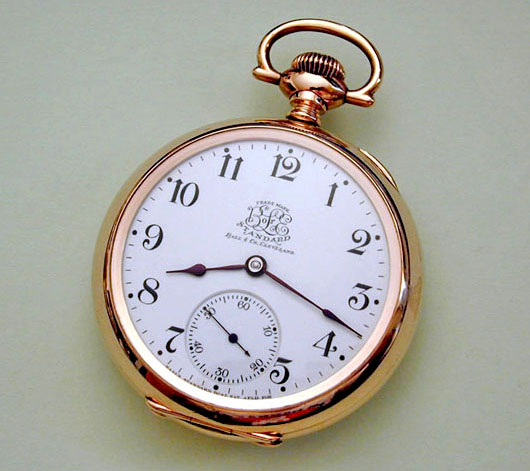 | |||
|
| Site Administrator IHC Life Member |
Very well written response Lin. And as usual a beautiful watch. | |||
|
Lindell, thanks for that information and the "adequate supply of dials remaining" makes sense to me. I have seen the BLE plugs for sale on Ebay but haven't seen other brotherhoods that I recall. Since these are so easily switched (held in by a set screw) that leads me to another question--is there a difference in the Waltham RR Standard movements and the Waltham BLE/ORC movements--other than the plug and dial? Was one group made to higher standards than the other or purely cosmetic? Clayton | ||||
|
| IHC President Life Member |
Thanks Phil Clayton, when you say an opinion makes sense that's really all we have to work with, an evaluation based on logic and experience along with what we find in leftover watchmaking and assembly material. This stuff surfaces every now and then so we keep our eyes open, remember what we see, and it all falls into place eventually. As to your question about whether or not there are any differences between the various Ball Brotherhoods and other ORRS movements... Although there were evolutionary changes over the years when we compare movements of the same time period they are identical except for the signature on the plug and the dial. It is therefore entirely reasonable to conclude that Ball-Waltham movements in arrived from the Waltham factory without the gold plug, dial or hands. Most likely they would have otherwise been essentially complete. At the Ball facility the appropriate plug and matching dial would be installed, along with the hands. (Similarly, on Ball-Hamilton 18s Brotherhoods the barrel cover and dial, those being easily changed components as well, were the only marked-as-Brotherhood items so once again they too would reasonably be matching at time of original sale) We know all the final adjustments, casing and timing were done "in-house" as well. This would be true until the 1930s when factory cased watches became the norm. So now you see why we believe that every Ball Brotherhood would have reasonably left with matching dial and movement. Webb C. Ball being one of the greatest if not the greatest watch merchandisers that ever lived it would be laughable to think he would have sold them any other way. Otherwise one would have to believe that Ball would intentionally dilute the value of his merchandise. The fact these watches could be so easily set-up in any desired configuration or if necessary changed to meet shifts in market demand was a truly remarkable merchandising plan even by today's standards. Contemplating all these details makes our hobby fun. What do you say? Lindell | |||
|
I think I'll have to quit work and concentrate on this full time if I'm ever to acquire as much information as you professionals have; and acquire additional memory chips too. Clayton | ||||
|
Hey Clayton, don't quit work! You won't have any money to buy watches, if you do! Cheers! Joel | ||||
|
FWIW, In my opinion, The most desirable acquisition would be a watch whose movement and dial matched. It is easy to imagine scenarios in which a mismatch would occur but there has been so much upgrading or switching in the last 30 years that I am leary. Not to mention that dials would routinely be replaced by repair men with newer stock. A 1905 watch with a broken or unsightly dial repaired in 1915. The repairman in those days wouldn't even imagine that was a problem. Today the collector is faced with the dilema of seeing so many mismatched examples that we have begun to validate them as "original" based more on our desire for it to be so than any serious documentation. Happy hunting, Bill Kapp | ||||
|
| IHC Life Member Moderator |
Good advice Bill, this is a thread to remember. Your advice along with the explanation and links Lindell provided to pictures of correctly matched watches makes the most important point. We are wise to be careful and acquire watches where everything matches. Don | |||
|
Hi Gents, attached are pic's of the 16s Ball Watch Co, Ball Waltham B of LE I just aquired. The serial # is B0505612. Hi Lindell, Hi Bill, can you tell me what yr this was made? I don't have a reliable database for Ball Walthams and any other info or comments on this watch is truely welcome. The balance is perfectly true but needs a cleaning badly, there is some litgh spotting on the small winding wheel and the gold BLE plug is there. The dial is beautiful with a slight hairline under the subseconds dial. The case is a Ball Model gold filled swing out with a pattern back. 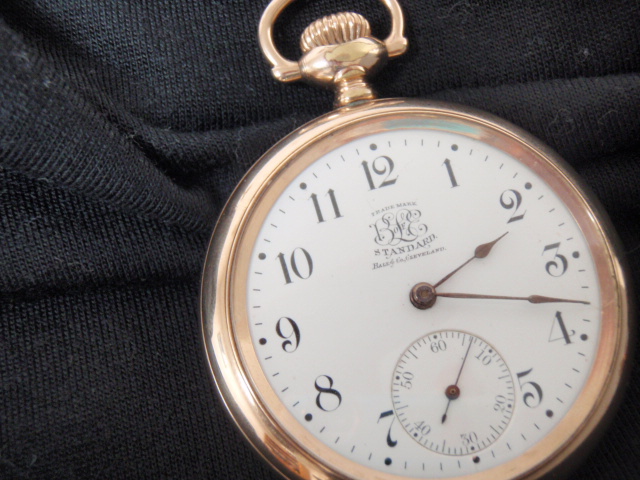 | ||||
|
dial 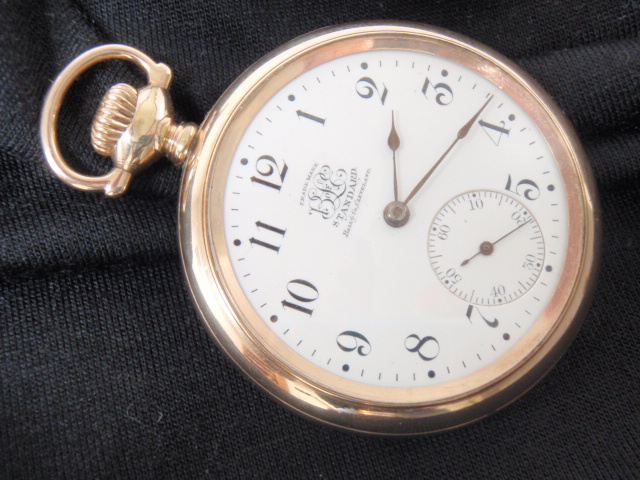 | ||||
|
dial no bezel 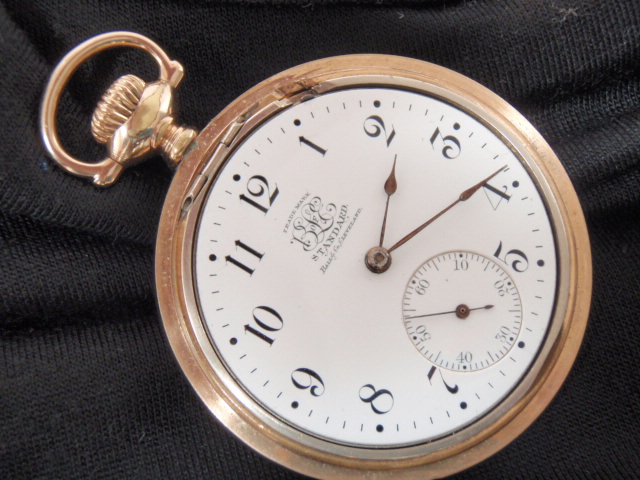 | ||||
|
dial angle  | ||||
|
movement  | ||||
|
movement 2 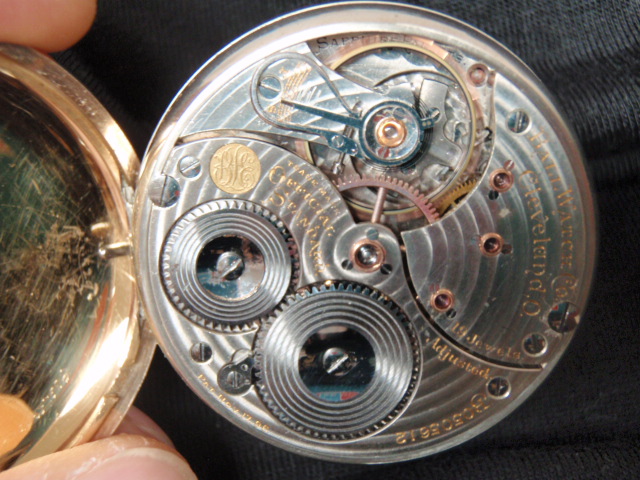 | ||||
|
case inside back 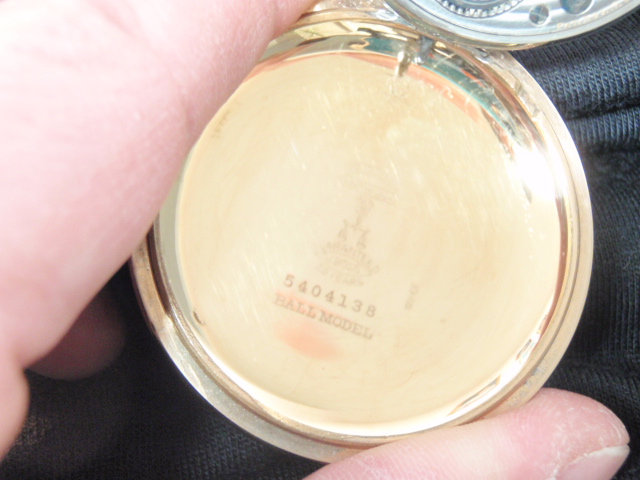 | ||||
|
case back  | ||||
|
case back 2 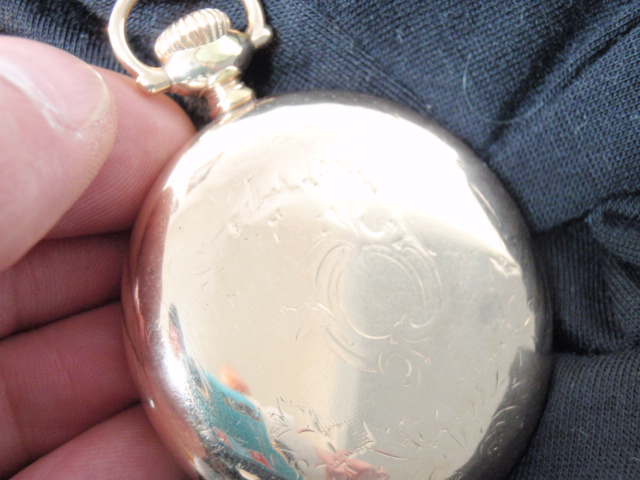 | ||||
|
| IHC President Life Member |
Hi Joe, You have a very nice example there! Nearly everything looks to be correctly marked and likely original right down to the correct seconds hand. The only incorrect component I see is the hour hand. That should be comparatively easy to find. The seconds hands were often knocked off as were the minutes hand, usually the hour hand avoids loss or damage. As to the production year, your number B0505612 is from a mixed-run of 500 of the 17 and 19-Jewel Ball-Waltham movements consisting of B505501 through B506000 during 1901 production, interestingly it turns out there are five runs of 500 listed for that year! As a further side-note there were about 64,000 of the 16-size Railroad Grade Ball-Walthams in 17, 19 and 21-Jewel configurations between 1899 and 1922 which shows they were very popular then as they are now. I am a big believer in 19-Jewel watches, these rank high among my personal favorites and furthermore I have often heard knowledgeable watchmakers say the 19-Jewel Ball-Walthams were one of the strongest and most reliable watches ever made. One final point, we believe these 16-size Ball-Walthams were the first Ball watches to be sold in specifically marked as "Ball-Model" cases and from my observations this likely began right after the turn of the 20th Century certainly by 1901 production. It would then be several years before this would spread across to the 18-size Ball-Hamiltons around the 1905-06 time-frame. Hope this is helpful to you and others, Lindell Ball advertisement promoting 17 and 19-Jewel watches... 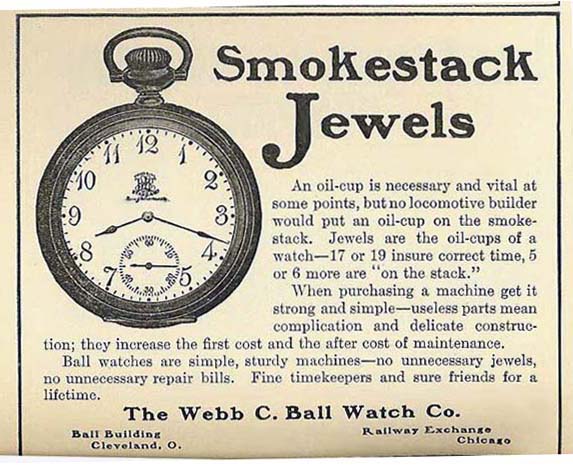 | |||
|
As always thank you for your imput Lindell, I love the Ball add you posted. Just a note...The hour hand on my watch looks identical to the example at the top of this thread posted from Joel Sarich. When looking at the watch in person the hour and minute hands are the same exact color (plumb) with the same aged patina. Do you have a picture of another example to compare the hour hand to? Thanks again, have a great evening. regards, Joe | ||||
|
| Powered by Social Strata |
| Your request is being processed... |
|
Welcome Aboard IHC185™  Internet Horology Club 185
Internet Horology Club 185  IHC185™ Discussion Site Main Page
IHC185™ Discussion Site Main Page  Open to the World RESEARCH FORUMS
Open to the World RESEARCH FORUMS  Ball Watch Company Research Forum
Ball Watch Company Research Forum  Ball - Waltham B of L E Pocket Watch
Ball - Waltham B of L E Pocket Watch
 Internet Horology Club 185
Internet Horology Club 185  IHC185™ Discussion Site Main Page
IHC185™ Discussion Site Main Page  Open to the World RESEARCH FORUMS
Open to the World RESEARCH FORUMS  Ball Watch Company Research Forum
Ball Watch Company Research Forum  Ball - Waltham B of L E Pocket Watch
Ball - Waltham B of L E Pocket Watch©2002-2025 Internet Horology Club 185™ - Lindell V. Riddle President - All Rights Reserved Worldwide

